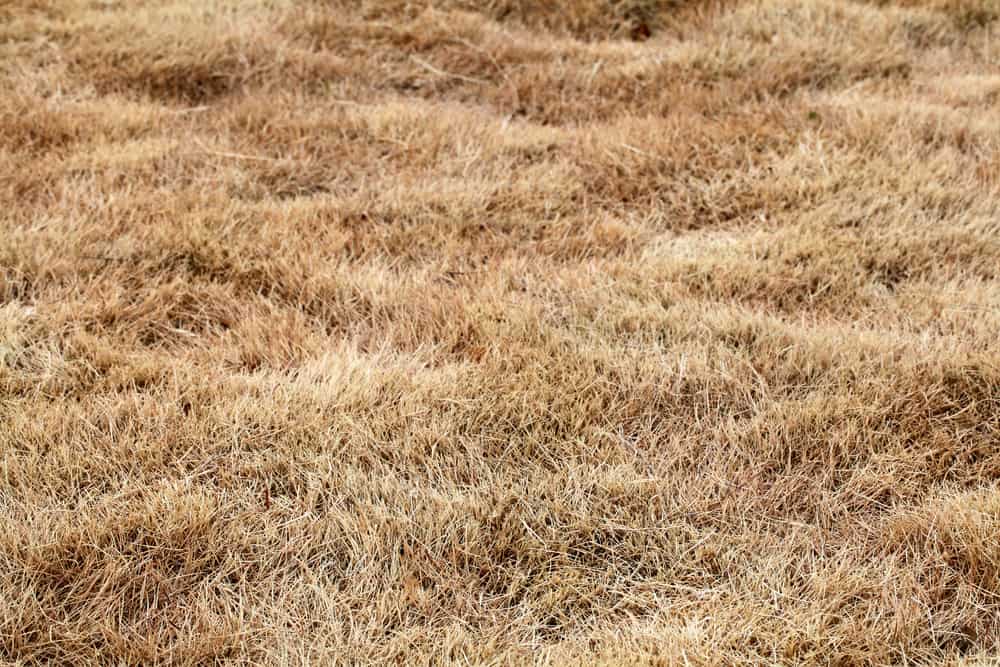One of the primary reasons that you may see your lawn turning yellow in the summer is the simplest reasons of all, drought. In many places water rates go up in the summer months, and there is less rainfall which leads to a suspension of water for the lawn and the lawn becoming dry and dehydrated.
However, there are even more reasons your lawn may turn yellow, there is fertilizer burn, urine from dogs that repeatedly use the same part of the lawn to relieve their bladder, infestations of insects, or lawn diseases are another possibility too.

You can fix your yellowing grass and turn it green again, of course the main thing to do is to find the root cause of the problem before you combat it, you do not want to apply the wrong solution and end up making things worse of course.
First, you want to thin out trees or bushes so that your grass gets plenty of sunlight, giving it extra sunlight will help it dry out better and keep it healthy, maintain a sharp mower and mow when the grass is dry.
Improve drainage, aerating the circulation to roots, water deeply, but infrequently, best in the morning to give them time to dry. Of course, fertilize as recommended and watch for weed competitors that may take resources from your lawn.
What color is healthy grass?
A healthy lawn will have a lush appearance and a bright-to-dark green color when they are healthy, well nourished and in their prime. Your lawn should be a lovely deep bright green color. If it is not this color then you probably have an issue.
Light green or yellow grass is an indicator of an issue, although it can be very difficult to pinpoint what this issue is as there are a few different things that could possibly cause this problem.
If your lush green lawn starts to discolor you will need to consider an array of aspects to the growing conditions of your lawn, as well as your management practices of your lawn in order to conclude the most likely cause of the discoloration.
The most common cause of discoloration is simply a lack of water, which is much more common than you may guess. Lass grasses can suffer from something call ed moisture stress, and they will wilt before they turn yellow.
You may not notice wilting in closely mowed lawns, hence discoloration may be one of the first signs of this. To resolve this simply irrigate the lawn.
However, do keep in mind that residual soil moisture varies from one patch of your lawn to another, so it is possible that irregular areas of poor coloration can actually be caused by moisture stress.
If you have a sprinkler you should confirm and check that the sprinkler distributes enough water to all parts of your lawn equally.
Why is my grass turning yellow and dying?
Your lawn can turn yellow in large patches, in small patches, or all over your lawn. It is also not an uncommon occurrence. There are many causes for color change in your grass, but since it is such a common problem, there are plenty of solutions, most of which are really simple to implement.
With a little care and love your wilting, yellowing, dying lawn will only be temporary, and it’ll be back to life in no time at all.
One of the causes of a yellow dying lawn is improper fertilization, if you over or under fertilize it can lead to issues, over-fertilization can cause chemical burns that will cause the grass to yellow and sometimes die.
On the other hand under fertilizing will cause the grass to suffer a nutrient deficiency and start to yellow. Grass also needs different nutrients during different seasons so be cautious of this too.
Urine is another cause, urine and feces contain a lot of nitrogen which have the ability to cause chemical burns to the lawn, so try to stop your pet from using the same spot as their bathroom if you can.
Over or under watering is another cause, overwatered grass gets clogged soil which cuts off oxygen and nutrients to the roots. Similarly, under watered grass becomes dehydrated and yellows.
Then there is lawn diseases, which is the worse culprit, these are often caused by fungi, this problem will often cause yellowed grass accompanied by a white, black or yellow powdery substance.
Will grass grow back after fertilizer burn?
While a lawn suffering from fertilizer burn may seem helpless, it is not. It is totally possible to get your lush lawn back after it has suffered fertilizer burn.
Though it is not as easy as just watering it, or just giving it more access to sunlight. You can treat your lawn to get its life back, there are some steps you can take to bring it back to life.
- Try to catch it as soon as it happens. If you have spilled a granular fertilizer, or if you can see it on the ground, grab yourself a broom or a wet and dry vacuum and try to clear up as much as you can before it dissolves into the lawn, the faster you tackle the problem the better.
- Apply some water to the affected area. Once you have noticed the issue with fertilizer burn get your sprinklers out or your hose, water will help to dilute and flush out the mineral salts from the roots of your lawn On the first day make sure to water until the ground cannot take anymore. Then water every day for a week, do so in the mornings to avoid fungal problems.
- Once this is done all you can do is wait and see if the lawn will recover. If it does not, wait until early springtime, so you have plenty of planting time left and then over seed in the thin spots, sow seed or sod in the large dead areas. And in the future be careful with your fertilizer.
